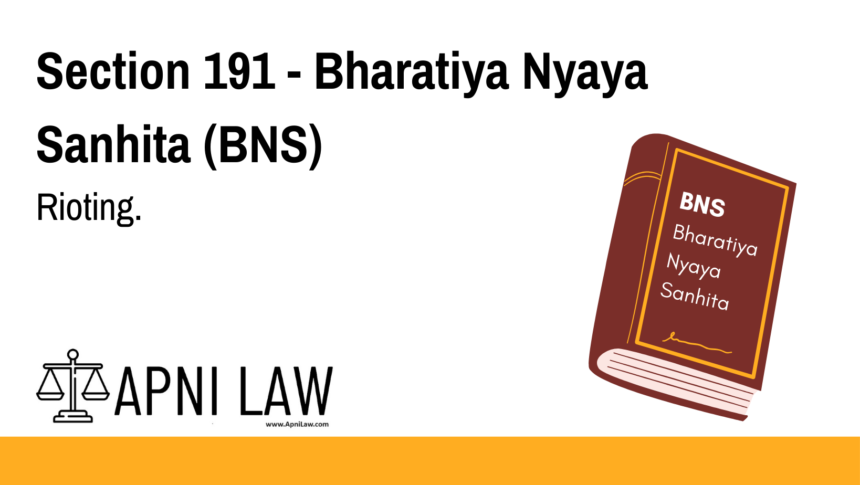Code: Section 191 BNS – Rioting
(1) Whenever force or violence is used by an unlawful assembly, or by any
member thereof, in prosecution of the common object of such assembly, every member of
such assembly is guilty of the offence of rioting.
(2) Whoever is guilty of rioting, shall be punished with imprisonment of either
description for a term which may extend to two years, or with fine, or with both.
(3) Whoever is guilty of rioting, being armed with a deadly weapon or with anything
which, used as a weapon of offence, is likely to cause death, shall be punished with
imprisonment of either description for a term which may extend to five years, or with fine, or
with both.
Explanation of Section 191 BNS
Section 191 of the Bharatiya Nyaya Sanhita (BNS), 2023, deals with the offence of rioting, which occurs when an unlawful assembly uses force or violence to achieve its common objective. Under this provision:
- If a group of five or more people gathers unlawfully and resorts to violence, all members of the assembly can be held guilty of rioting.
- The punishment varies depending on whether the rioters are armed or unarmed.
- A person involved in rioting without weapons may face up to two years of imprisonment.
- If the offender carries a deadly weapon, the punishment increases to five years.
Key Elements of Rioting
- Presence of an Unlawful Assembly – The gathering must be unlawful as per Section 190 BNS.
- Use of Force or Violence – Mere unlawful assembly is not rioting unless force or violence is used.
- Common Object – The force must be used to achieve the group’s common unlawful objective.
- Participation of Members – Every member of the unlawful assembly is guilty, even if they did not personally use violence.
Illustration
Example 1: Mob Violence During a Protest
A group of ten individuals gathers unlawfully and starts vandalizing public property. Some members throw stones at the police. Even though only a few were physically violent, all members can be charged under Section 191 BNS for rioting.
Example 2: Rioting with Weapons
During a land dispute, a group of people armed with knives and rods forcibly evicts another group. Since they were carrying deadly weapons, they can be punished under Section 191(3) BNS, with imprisonment of up to five years.
Common Questions and Answers on Section 191 BNS
1. What is the difference between an unlawful assembly and rioting?
- Answer: An unlawful assembly (as defined under Section 190 BNS) is simply a gathering with an illegal objective. Rioting occurs when that assembly uses force or violence to achieve its goal.
2. Can a person be guilty of rioting if they did not personally engage in violence?
- Answer: Yes. If a person is part of an unlawful assembly that engages in violence, they can be charged with rioting, even if they did not personally commit violent acts.
3. What is the punishment for rioting with weapons?
- Answer: If a person participates in rioting while armed with a deadly weapon, they can face up to five years of imprisonment, as per Section 191(3) BNS.
4. Is rioting a bailable offence?
- Answer: Basic rioting (under Section 191(2) BNS) is bailable, but rioting with deadly weapons (under Section 191(3) BNS) is non-bailable, meaning bail is at the discretion of the Court.
5. How can one defend against a charge of rioting?
- Answer: Defenses include:
- Proving non-participation – The accused was not part of the unlawful assembly.
- Lack of violence – No force or violence was used.
- No common object – The accused had no unlawful intent.
Conclusion
Section 191 BNS is a crucial legal provision aimed at preventing mob violence and riots. It penalizes individuals involved in unlawful assemblies that turn violent, with stricter punishments for those carrying weapons. Understanding this law is essential to ensuring law and order while safeguarding individual rights.
For expert legal insights, visit ApniLaw today! 🚀








